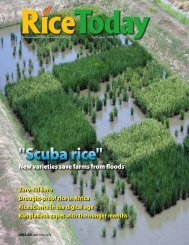How much water does rice need? - adron.sr
How much water does rice need? - adron.sr
How much water does rice need? - adron.sr
Create successful ePaper yourself
Turn your PDF publications into a flip-book with our unique Google optimized e-Paper software.
MapsSoil quality in rainfed lowland <strong>rice</strong>by Stephan Haefele and Robert HijmansRainfedlowland <strong>rice</strong> Aagroecosystemsare characterizedby fields that areflooded for at leastpart of the growingseason, but thatare not irrigated.Asia has about 46million hectaresof rainfed lowland<strong>rice</strong>, constituting Calmost 30% of theglobal <strong>rice</strong> area.Rice production inthese ecosystems—often hamperedby drought,submergence, andproblem soils—isassociated withlow productivity,and with ahigh incidenceof poverty.Recent technological advances,such as the development of stresstolerant<strong>rice</strong> varieties and improvedcrop-management options, can helpboost yields substantially. <strong>How</strong>ever,such benefits depend stronglyon the quality and availability ofnatural resources, particularly soiland <strong>water</strong>. Here, we present mapsthat help characterize soil qualityand soil-related constraints inrainfed lowland <strong>rice</strong> ecosystems(excluding deep<strong>water</strong> <strong>rice</strong>) in Asia. 1,2Map 1. Soil quality in areas where rainfed lowland <strong>rice</strong> is grown in Asia.We transformed the data ofthe Soil map of the world 3 bycreating four soil quality groups. 4The first two groups—“good” and“poor” soils—do not have majorsoil chemical constraints but differin their degree of weathering (thephysical and chemical breakdown ofsoil over time) and, therefore, theirindigenous soil fertility (the amountof nutrients the soil can supply). Thethird group—“very poor”—representshighly weathered soils that arelikely to have multiple soil chemicalBDconstraints to crop growth (such asacidity, severe phosphorus deficiency,and iron and aluminum toxicities).The last group—“problem soils”—combines the most frequently citedsoil problems, including acid-sulfate,peat, saline, and alkaline soils,which partly cause low fertility, andpartly cause soil chemical toxicity.Although not widespread,problem soils are locally important,especially in northern India (sodicsoils); in some coastal lowlands ofBangladesh, Myanmar, Thailand,1Our approach is based on that of Garrity DP, Oldeman LR, Morris RA. 1986. Rainfed lowland <strong>rice</strong> ecosystems: characterization and distribution.In: Progress in rainfed lowland <strong>rice</strong>. International Rice Research Institute (IRRI), Los Baños, Philippines. p 3-23.2For more details, see Haefele SM, Hijmans RJ. 2007. Soil quality in <strong>rice</strong>-based rainfed lowlands of Asia: characterization and distribution. In:Aggarwal PK, Ladha JK, Singh RK, Devakumar C, Hardy B, editors. Science, technology, and trade for peace and prosperity. Proceedings of the26th International Rice Research Conference, 9-12 October 2006, New Delhi, India. IRRI, ICAR, and NAAS. p 297-308.3Food and Agriculture Organization of the United Nations: The digital soil map of the world. An updated version is available from www.iiasa.ac.at/Research/LUC/luc07/External-World-soil-database/HTML/index.html.4To do this, we simplified the Fertility Capability Soil Classification (FCC) system, which classifies soil types into agronomically relevant groups.See Sanchez PA, Palm CA, Buol SW. 2003. Fertility capability soil classification: a tool to help assess soil quality in the tropics. Geoderma114:157-185.30 Rice Today January-March 2009

















